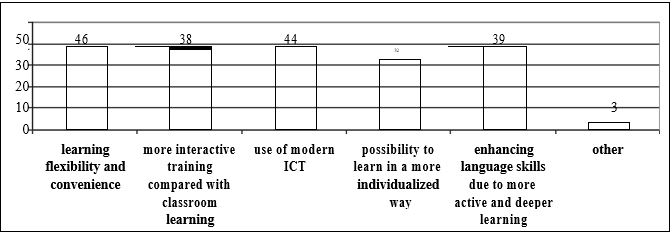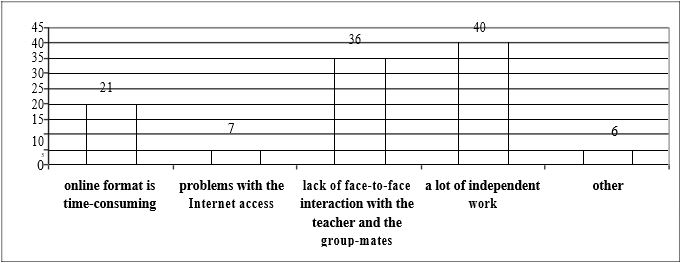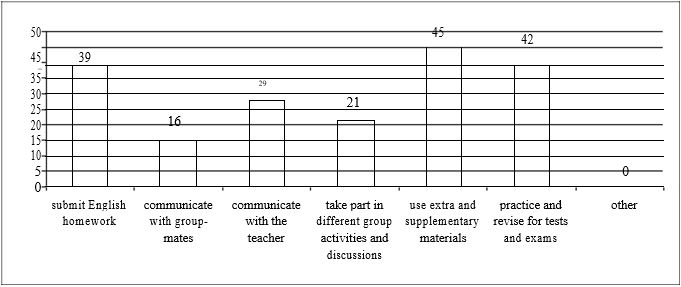Abstract
The paper aims to discuss the issues of blended learning integration to upgrade foreign language training for university students of non-linguistic disciplines. The paper considers the nature and the peculiarities of the blended learning technology. The effectiveness of blended learning in foreign language training is corroborated as this technology has several advantages that can improve the quality of foreign language training for non-linguistic undergraduate students. The primary objective of the research was to find out university students’ attitude towards blended learning applied to their English as a second language (ESL) course. The general goal was to see if the students were satisfied with using the blended approach implemented in their English course. We also tried to reveal if blended learning has advantages which enhance English as a foreign language learning and training for university students of non-linguistic disciplines. We used the points of view of non-linguistic undergraduate students from Kozma Minin Nizhny Novgorod State Pedagogical University. The conclusions are drawn on the benefits of blended learning in foreign language training at a non-linguistic university. The findings of the research can have an impact on the optimization of learning processes and effective teaching students of non-linguistic disciplines.
Keywords: Blended learningeffective teachingESL coursenon-linguistic universitystudents’ perceptionstraining
Introduction
But a range of some factors may prevent achieving the goal named above. Some possible causes should be highlighted. They are a lack of time in the classroom given to foreign language disciplines (Foreign Language; Foreign Business Language; Foreign Language for Specific Purposes) at non-linguistic universities; the use of traditional teaching models and methods; different levels of proficiency of foreign language students within one group (Mukhina & Musina, 2019); a lack of motivation for learning foreign languages (Arkhipova et al., 2018; Artamonova, 2015; Mineeva & Liashenko, 2018); a high rate of absenteeism, a lack of self-control and self-discipline while studying when it is necessary (Bogorodskaya et al., 2018).
Problem Statement
Blended learning has the potential to solve the problems of enhancing foreign language training for university students of non-linguistic disciplines. The blended approach can be integrated into any language course it provides students with the opportunity to acquire knowledge on their own, to use all resources and benefits offered by the information and computer technologies (ICT) while face-to-face interactions with the teacher.
Blended learning as an approach is a common concept in higher education nowadays. The recent literature review reveals a great body of extensive research on the essence of blended learning. The specificity and possibilities of using blended learning are investigated by both Russian and foreign scientists. Although there are a lot of definitions of blended learning, the term “blended” is commonly described as an environment which combines different learning approaches, modes of teaching and media. Blended learning can also be defined as a mix of traditional face-to-face training in the classroom, self-directed learning and online collaborative activities. According to Atef and Medhat (Atef & Medhat, 2015), blended learning is structured opportunities to learn, which use more than one learning or training method, inside or outside the classroom. Arkhipova et al. (2018) indicated that blended learning provides learners with teacher’s support both in the classroom and in electronic educational environments. Colis and Moonen (2001) insist on the fact that blended learning is an effective integration of different learning environments so that instruction occurs both in the classroom and online and the online components are a natural extension of the traditional classroom learning. Blended learning is also indicated as a tool for the development of learners’ autonomy, confidence, responsibility, activity, and creativity (Garrison & Vaughan, 2008; Shurygin & Krasnova, 2019).
Research Questions
The use of blended learning in the educational process takes place due to several advantages of this technology. They are: the improving of education quality by organizing students' effective independent work (Tsvetkova & Malisheva, 2019), the availability of feedback from the teacher, providing students with all the necessary educational, methodological materials and reference (Shand & Farrelly, 2017), the availability of effective tools for managing the educational process, the flexibility of training (Akbarov et al., 2018). However, there are some disadvantages of blended learning which do not go unnoticed. They are the need for constant proper access to the Internet, the low level of teachers’ IT literacy, students' difficulties in mastering the content without regular face-to-face communication with the teacher, the complexity of creating electronic educational content, a lack of students’ readiness for self-tuition (Mineeva et al., 2018).
The use of blended learning in foreign language training at a university lets a teacher employ a wide range of teaching methods and tools which are necessary to expand learning opportunities and optimize the process of developing university students’ communicative competence.
The blended learning approach has benefits both for students and teachers. Here are some of them:
teachers can consider students’ individual preferences, psychological features and learning styles. As for students, with the help of blended learning, they can study a foreign language in their preferable form and way of learning. They can work in a way which suits them since several tasks are performed in the electronic educational environment asynchronously. As for teachers, blended learning helps them to respond to students’ different learning styles, maximizing the strengths of each learning environment. The teacher can develop curricula considering students’ psychological traits such as perception and memory, temper and thinking to practice various teaching methods. Blended learning lets teachers develop various activities both online and, in the classroom, thus students can fulfil tasks both individually, in pairs or in small groups. Moreover, the blended approach is especially appropriate for foreign language learning as the content can be presented not only in written texts but also in aural and visual formats. It also leads to easier foreign language acquisition and use;
a deeper study of the taught material. The lessons which were taught previously in the classroom are available in the electronic educational environment and students can study, consolidate or go back to refresh their knowledge as many times as they need. For example, students, who have already studied theory, can recollect it later as needed. Tests and different kinds of assignments are usually not limited by the number of attempts, so students can do them as many times as they consider them to be necessary for deeper learning. The understanding of foreign speech causes traditionally increased difficulties for students, including psychological ones. Students can watch videos or listen to audio texts in the electronic educational environment as many times as needed for understanding the necessary information. Students can read texts taking their time to reflect on it without feeling slow or use the dictionary if it is necessary. Thus, all these factors will contribute to the improvement of the target language knowledge;
availability of rich interactive content. Blended learning offers various interactive learning materials which are available through audio, video, graphics and which are relevant to students’ interests and communication needs (Kaznacheeva & Bondarenko, 2018). The material used in the electronic educational environment can be uploaded by the teacher (for lower-level learners) or the students (higher level learners) can be involved in preselecting and creating content while surfing the Internet. This interactive content can help teachers make online courses that suit students’ various learning styles or language levels;
increasing social interaction during face-to-face classes. Communication as the main type of social activity can be best applied in the classroom environment. Blended learning lets the teacher and the students have more time for collaboration and communication. Thereupon, it’s worth noting the application of the following active teaching methods which imitate real communication: round-table discussions, presentations, role-plays and business games. The teacher can devote more time to discussing interesting and important topics or to checking the knowledge which students have gained online. In the classroom, students can also ask questions to clarify some language points (pronunciation, grammar, vocabulary, usage etc.);
providing students with just-in-time support. Direct contact with the teacher and information help are the crucial parts of the learning process which are used to increase students’ motivation to study a foreign language and enhance training quality. E-learning as an important part of blended learning supplies students with teaching material and resources (different types of culture and grammar notes, links to extra resources, etc.) available online in the electronic educational environment. Moreover, chats and discussion forums offer immediate feedback.
increasing students’ motivation to study a foreign language. According to Prensky (2001), present-day students belong to the digital generation – people raised in the digital, media-saturated world. He highlights that rapid dissemination of digital technology changed the way students think and process information making it difficult for them to gain knowledge taught by outdated teaching methods. Thus, a media-rich learning environment helps hold students’ attention and stimulate their interest, and learning activity positively affecting their learning as well as their motivation for foreign languages (Sumarni & Raihan, 2012). Moreover, as most non-linguistic undergraduate students have instrumental motives, they consider ICT and the Internet as a means of communication with the members of the society that speak the foreign language.
Purpose of the Study
In the study, we aimed at finding out university students’ attitude towards blended learning applied to their English as a foreign language course. The general goal was to see if the students were satisfied with using e-learning environment in the English course context. We also tried to reveal if blended learning has advantages which can enhance English as a foreign language for university students of non-linguistic disciplines.
Research Methods
Procedure
The study employed a survey method. The data were collected via an online survey using a Google Form prepared by the researchers. The questionnaire was conducted with 5 questions. The questionnaire was provided in Russian. All respondents took part in the survey on their own free will. The following questions were asked in the questionnaire form:
Do you like the blended approach implemented in your English course?
What are the advantages of blended learning? (Choose the answers you like most or suggest your ideas).
What are the disadvantages of blended learning? (Choose the answers you like most or suggest your ideas).
What do you use the electronic educational environment for? (Choose the answers you like most or suggest your ideas).
Which type of studying do you prefer: classical classroom learning, blended learning, e-learning?
Participants
The participants of the survey are 46 undergraduate students of Kozma Minin Nizhny Novgorod State Pedagogical University, Russian Federation. They are 19 first-year students (41.3%) and 27 second-year students (58.7%) whose age varies from 17 to 19. All respondents are non-linguistic undergraduate students learning English as a foreign language. As for the skills and knowledge of English, 26 participants (56.5%) are at the pre-intermediate level, 13 participants (28.3%) are at the intermediate level, 4 students (8.7%) have the elementary level and 3 students have the upper-intermediate level of English. The survey was held in 2018/2019 academic year at the end of the spring term.
Findings
The obtained results of the survey are presented below.
Figure
The analysis of quantitative data has proved positive students’ perceptions of the blended approach implemented in their English course. Hence, we can suppose that blended learning is the necessary tool which can solve the problems of enhancing foreign language training for undergraduate students of non-linguistic disciplines increasing their interest and motivation.

Regarding the advantages of blended learning presented in Figure
The possibility to study where and when it is convenient for the students seems to be the most significant advantage of blended learning. The majority of the respondents have also opted for using modern ICT. Their choice proved again that the students have a positive attitude toward blended learning used in their English course. It is also important for most students that blended learning gives them opportunities for deeper learning and chances to study in a more personalized way. Having analyzed the listed advantages, we can suppose that blended learning can become a bridge between the traditional and electronic learning in ESL courses at the university.

Speaking about the disadvantages of blended learning in the English course context (Figure
Concerning the disadvantages of blended learning, respondents point out to the fact that not all students are confident and disciplined enough or ready for regular self-study during their English course. They also pay special attention to face-to-face communication and direct contact with the English teacher. Considering the special features of the foreign language learning process, we can assert that blended learning can be a good supporting means of ELS teaching.

Figure
The next important result is that most students tend to use the electronic educational environment as the means of receiving information or supplementary material and self-study, but they underestimate its potential as a communication tool in the ESL course.

According to the preferable type of studying (Figure

The opting for blended learning has confirmed our supposition that teachers do not have to neglect ICT application in foreign language courses. Students prefer using their digital devices for educational purposes. English teachers have to understand that using ICT provides a productive learning process as well as it helps increase and support non-linguistic students’ motivation to learn foreign languages. And the teacher, in turn, needs to choose an appropriate blend and consider which part of the course should be performed online and which part of the course should be in the classroom.
Conclusion
The results of the study revealed that university students have a positive attitude to blended learning applied to their English as a foreign language course. They are satisfied with the blended approach in their English course. The students consider that blended learning makes it possible to enhance their language skills due to more active and deeper learning. They also mark that the blended approach provides more interactive training compared to classroom learning.
Hence, the concept of blended learning can be successfully integrated into foreign language training at the university. This technology lets English teachers solve some problems of developing communicative competence as well as to promote effective teachers and students’ time organization and to increase the effectiveness of foreign language training for students of non-linguistic disciplines. But the teacher has to develop the content and process of teaching a foreign language carefully: it is necessary to organize the training material, to choose teaching methods, assessment and evaluation forms, and consider factors contributing to the steady students’ motivation for the target language.
References
- Akbarov, A. A., Gönen, K., & Aydoğan, H. (2018). Students’ attitudes toward blended learning in EFL context. Acta Didactica Napocensia, 1(1), 61-68.
- Arkhipova, M. V., Belova, E. E., & Shutova, N. V. (2018). On Motivation of Learning English as a Foreign Language: Research Experience in Russian University Context. Advances in Intelligent Systems and Computing, 677, 13-121.
- Arkhipova, M. V., Belova, E. E., Gavrikova, Yu. A., Lyulyaeva, N. A., & Shapiro, E. D. (2018). Blended learning in teaching EFL to different age groups. Advances in Intelligent Systems and Computing, 622, 380-386.
- Artamonova, G. V. (2015). The role of motivation in the process of autonomous students’ activity in studying a foreign language. Azimuth of Scientific Research: Pedagogy and Psychology, 3(12), 7-9.
- Atef, H., & Medhat, M. (2015). Blended learning possibilities in enhancing education, training and development countries: a case study in graphic design courses. TEM-Journal, 4(4), 358-365.
- Bogorodskaya, O. V., Golubeva, O. V., Gruzdeva, M. L., Tolsteneva, A. A., & Smirnova, Z. V. (2018). Experience of approbation and introduction of the model of management of students’ Independent work in the university. Advances in Intelligent Systems and Computing, 622, 387-397.
- Colis, B., & Moonen, J. (2001). Flexible Learning in a Digital World: Experiences and Expectations. Kogan-Page.
- Garrison, D. R., & Vaughan, N. D. (2008). Blended Learning in Higher Education: Framework,
- Kaznacheeva, S. N., & Bondarenko, V. A. (2018). Investigation of readiness of students of non-linguistic specialities to use network resources when studying foreign languages. Vestnik of Minin University, 6(2), 8. https://doi.org/10.26795/2307-1281-2018-6-2-8
- Mineeva, O. A, Prokhorova, M. P., Borshtchevskaya, Yu. M., & Terekhina, A. Ye. (2018). Students’ perception of advantages and disadvantages of using LMS Moodle. Azimuth of Scientific Research: Pedagogy and Psychology, 7(4), 162-165.
- Mineeva, O. A., & Liashenko, M. S. (2018). Exploring motivation for studying foreign languages among students of non-linguistic disciplines. Humanitarian Journal, 7(4), 269-273.
- Mukhina, T. G., & Musina, N. I. (2019). Formation of readiness of future specialists of the ministry of international affairs of Russia to the interpersonal interaction in a multi-ethnic environment. Vestnik of Minin University, 7(1), 3. https://doi.org/10.26795/2307-1281-2019-7-1-3
- Prensky, M. (2001). Digital Natives, Digital Immigrants. On the Horizon, 9(5), 1-6.
- Principles, And Guidelines. Jossey-Bass.
- Shand, K., & Farrelly, S. G. (2017). Using Blended Teaching to Teach Blended Learning: Lessons Learned from Pre-Service Teachers in an Instructional Methods Course. Journal of Online Learning Research, 3(1), 5-30.
- Shurygin, V. Yu., & Krasnova, L. A. (2019). Blended learning in the system of training of teachers qualification. Baltic Humanitarian Journal, 8(1), 324-328.
Copyright information

This work is licensed under a Creative Commons Attribution-NonCommercial-NoDerivatives 4.0 International License.
About this article
Publication Date
28 December 2020
Article Doi
eBook ISBN
978-1-80296-098-3
Publisher
European Publisher
Volume
99
Print ISBN (optional)
-
Edition Number
1st Edition
Pages
1-1040
Subjects
Multicultural context, learning environment, modern society, personality formation, informatization of the society, economics and law system of the region
Cite this article as:
Mineeva, O., Liashenko, M., Prokhorova, M., Tsvetkova, S., & Charchoglyan, T. (2020). Examining Students’ Perceptions of Blended Learning in the ESL Course. In N. L. Shamne, S. Cindori, E. Y. Malushko, O. Larouk, & V. G. Lizunkov (Eds.), Individual and Society in the Modern Geopolitical Environment, vol 99. European Proceedings of Social and Behavioural Sciences (pp. 678-686). European Publisher. https://doi.org/10.15405/epsbs.2020.12.04.78

